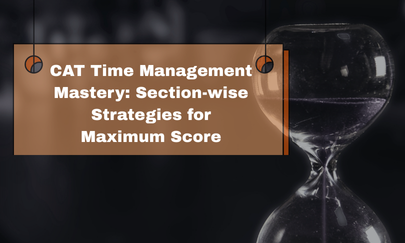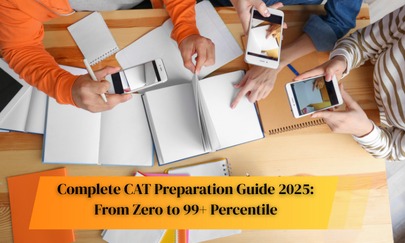
- First Things First: Understand the MAT Exam Format
- Section 1: Language Comprehension
- Section 2: Intelligence & Critical Reasoning
- Section 3: Mathematical Skills
- Section 4: Data Analysis & Sufficiency
- Section 5: Economic & Business Environment
- Final Exam Strategy: How to Approach MAT as a Whole
- Closing Thoughts: Be Strategic, Not Just Studious
“How should I approach the MAT exam?”
If you’re asking this question, you're already one step ahead of many aspirants.
The Management Aptitude Test (MAT) is your gateway to 600+ B-schools across India. But let’s be honest—just knowing the syllabus isn’t enough. What really matters is knowing the exam pattern inside-out and having a smart section-wise strategy.
Don’t worry—I’ve got you. Let’s break down the MAT exam in simple, non-boring terms and look at how you can confidently handle each section.
First Things First: Understand the MAT Exam Format
Before we go section-by-section, here’s a quick snapshot of the MAT exam structure:
|
Section |
|
Suggested Time |
|
||||
|
Language Comprehension |
30 |
25 mins |
80–85% |
||||
|
Intelligence & Critical Reasoning |
30 |
25 mins |
80%+ |
||||
|
Mathematical Skills |
30 |
30 mins |
70–75% |
||||
|
Data Analysis & Sufficiency |
30 |
25 mins |
75% |
||||
|
Economic & Business Environment |
30 |
10-15 mins |
Low weightage |
||||
|
TOTAL |
150 |
120 mins |
|
Each question carries 1 mark, and there’s a negative marking of 0.25 per wrong answer.
Section 1: Language Comprehension
What’s it about?
This is not just about vocabulary or grammar—it's also about how well you understand and process English.
What You'll See:
- Reading Comprehension (RC) passages
- Vocabulary (synonyms/antonyms, one-word substitutions)
- Sentence correction
- Para jumbles
- Fill in the blanks
Tips to Master It:
- Read daily – Editorials from The Hindu or Indian Express are gold.
- RC Strategy – Don’t read line-by-line. Skim the passage first, then look at the questions.
- Learn by context – Don’t memorize 1000 vocab words. Understand how they’re used in sentences.
- Practice para jumbles – These are tricky but very scorable once you understand the structure.
Human Tip: If English isn’t your strong suit, don’t panic. It’s about comprehension, not perfection.
Section 2: Intelligence & Critical Reasoning
What’s it about?
This is the “logic” section—and no, you don’t need to be Sherlock Holmes to crack it.
What You'll See:
- Blood relations
- Coding-Decoding
- Series & Patterns
- Statements & Conclusions
- Syllogisms
- Puzzles
- Assumptions & Arguments
Tips to Master It:
- Practice is key – There’s no theory here. The more you solve, the faster you get.
- Draw it out – Blood relations and puzzles are best solved visually.
- Don’t overthink – Go with logic, not assumptions.
- Use elimination – If the options don’t follow logically, they’re out.
Human Tip: Think of this as a brain game. The more fun you make it, the better you'll get.
Section 3: Mathematical Skills
What’s it about?
Good ol’ Quant. But don’t worry—you don’t need IIT-level maths here.
What You'll See:
- Arithmetic (percentages, ratios, profit & loss, SI/CI)
- Algebra (linear & quadratic equations)
- Geometry & Mensuration
- Number Systems
- Time-Speed-Distance & Time-Work
- Probability, Permutation & Combination
Tips to Master It:
- Focus on Arithmetic – Around 50% of questions come from here.
- Learn tricks – Vedic maths shortcuts can save precious seconds.
- Revise formulas – But also know when and how to apply them.
- Avoid time traps – Don’t waste 10 minutes on one question. Mark and move on.
Human Tip: This section is less about brilliance and more about time management.
Section 4: Data Analysis & Sufficiency
What’s it about?
This is data interpretation—charts, tables, and number-based reasoning.
What You'll See:
- Bar graphs
- Pie charts
- Line charts
- Caselets (paragraph-based data)
- Data sufficiency questions
Tips to Master It:
- Read the question first – Don’t dive into the chart without knowing what to look for.
- Approximate – Don’t aim for perfect calculations. Round off smartly.
- Know the basics – Percentages, averages, ratios will come in handy.
- Skip the heavy ones – Some charts look intimidating on purpose. Move on if needed.
Human Tip: This section can be a high-scorer if you don’t panic at the sight of numbers.
Section 5: Economic & Business Environment
What’s it about?
This is the GK section. The twist? It’s not counted in your composite score for most B-Schools!
What You'll See:
- Current affairs (past 6–12 months)
- Static GK (countries, capitals, awards, economy, business)
- Sports, politics, major events
Tips to Master It:
- Use mobile apps – Inshorts, GK Today, or even Instagram pages that share daily news updates.
- Focus on business & economy – MAT is a management exam, after all.
- Don’t stress too much – 10–15 minutes max for this section. Don’t let it affect your core score.
Human Tip: Treat this like a bonus round. If you know it, great. If not, move on.
Final Exam Strategy: How to Approach MAT as a Whole
Here’s a simple plan for exam day:
- Start with your strength – Build confidence in the first 30 minutes.
- Stick to time limits – Even if you’re mid-question, move on.
- Use rough space wisely – Especially for DI and puzzles.
- Don’t try to attempt all 200 – Quality over quantity.
- Mark and move – Flag doubtful questions, revisit them later if time permits.
Closing Thoughts: Be Strategic, Not Just Studious
MAT isn’t about being the smartest in the room. It’s about being calm, clear-headed, and strategic.
Focus on accuracy, not just speed. Don’t let one tough question shake your entire confidence. And most importantly, practice in exam-like conditions—with a timer and zero distractions.
MAT gives you multiple attempts a year, but if you play your cards right, you’ll only need one.












